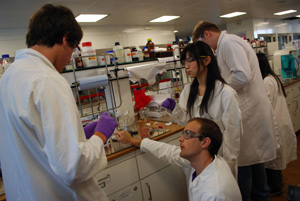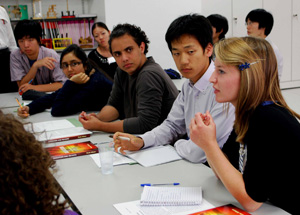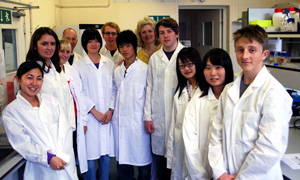| |
|
|
UK-Japan Young Scientist Workshop in Cambridge
Students from schools in Japan and the UK recently got together in Cambridge to attend a week-long
young scientist workshop. Thanks to generous donations, this year the Workshop welcomed participants
from schools in the Tohoku area which had suffered in the March 11 earthquake and tsunami.
|
Impressions of a participant from Tohoku
From 24 to 29 July I joined the UK-Japan Young Scientist Workshop 2011 at Cambridge. I was invited as a student from the Tohoku area, which was damaged by the severe earthquake and tsunami. Let me first say something about the disaster I experienced.
After the earthquake, my school in Sendai was closed for more than one month, because it was almost impossible for many students to go to school. We were suffering from lack of food and water, and the fear of radiation. Nonetheless, many friends of mine worked as volunteers to help those who were living at the elementary school, which was being used as a shelter. I did so as well.
|

Students in the chemistry project studying gold nanoparticles
©Clifton Scientific Trust |
After the hard period, we had as fulfilling a school life as before the earthquake. It was partly because our school wasn’t near the sea front and avoided the direct damage from the tsunami. Now, most of the students in our school don’t think of themselves as victims of the disaster. Actually, our school council raised funds for survivors of the tsunami and many people in my prefecture are doing their best to help them. Through this experience, I think I should study science harder to protect people from disasters like this. I feel this is an important role for those who survived, and it encouraged me to apply for the workshop in Cambridge.
My programme in Cambridge was 'Radiation and Tsunami' by Professor Wade Allison, who argues against exaggerating the dangers of radiation. Since he put importance on discussion among the participants, I was able to exchange many opinions about the safety of radiation, the problems over 'Fukushima', and so on. Through the lectures from Prof. Allison and the discussions we had, I thought it was truly important to collect information and make our own decisions not emotionally but scientifically.
|

Students in discussion in the Radiation in the Environment project. Tomosato Hioki is second from the right
©Clifton Scientific Trust |
What impressed me the most was the English students’ attitude in the discussions and lectures. They were always trying to ask questions and they listened carefully to us, the Japanese students, even though our English was not good. Thanks to them, I was able to join in the discussions and express my opinions in English. I was very happy, and at the same time I thought I should learn how to take part in productive discussions like my English friends.
I think this kind of workshop will be good motivation for Japanese students to study and play an active role in science abroad. Actually, I’d like to study in England someday. Finally, I’d like to express my appreciation to everyone who supported this workshop and to all my English friends who made it more exciting. THANK YOU VERY MUCH!
Tomosato Hioki, Dai-ni High School, Sendai |
A British perspective
From 24 to 30 July 2011, high school students from across Japan from the Fukushima area to Tokyo stayed at the Kaetsu Centre at Murray Edwards College in Cambridge with students from all over England. The week-long summer workshop was organised by Clifton Scientific Trust, a charity whose aim is to motivate students and to use the global topic of science to overcome cultural barriers in order to create international links for the future.
Although science was the main focus of the workshop, the aspect of cultural exchange proved very important, with students from both schools attempting to overcome any differences and learn about each other’s countries. We were thrown into the Japanese culture straight away as we shared rooms with our Japanese partners, giving us the opportunity to learn some Japanese and to help them improve their English as well as learning about their culture, from making origami birds to trying sushi!
|
On the second day the projects began! There was a wide choice covering all aspects of science – electronics, physics, biology and chemistry. Personally I was part of the biological anthropology group where we looked at identifying primates with PrIME, a research group run by Dr Leslie Knapp at Cambridge University. We looked at the genetic methods of identifying animals by extracting DNA from faecal samples, then amplifying the X and Y chromosomes by PCR followed by performing agarose gel electrophoresis to determine whether the samples were from male or female individuals. We also spent time discussing how to tell the gender and relationships of primates in the wild by looking at their facial features before practising this in an observation of lemurs and tamarins at Linton Zoo the next day. |

Students and Scientists in the PrIME Project Team.
Natalie Weller is second from the left.
©Clifton Scientific Trust |
The science projects gave us all a new outlook on the science we learn in the classroom, showing us the practical applications and what it would be like to work in a real research group at Cambridge University, with many of us working on topics that we had never encountered before. It allowed us to work for a week on the forefront of science as we helped the researchers to progress towards the answers to new questions in their field of science.
The evenings were culturally enlightening but also incredibly fun as we practised the art of calligraphy – learning how to write our names in Japanese and also about the strict stroke order that must be followed! A maths activity run by Dr Vicky Neale, a fellow from Murray Edwards College, was useful in helping both nationalities to communicate through the use of the universal language of mathematics – and we also learnt about how there is not always only one right answer to maths problems. During another evening we had a gift exchange where typically English presents such as fudge, London-themed trinkets and chocolate were swapped with Japanese presents. Each school also made a presentation to display an aspect of their country’s traditions. My school, Colchester County High School for Girls, taught the Japanese students the Hokey Cokey and we also participated in games of pass the parcel and musical chairs, and watched a performance of the famous balcony scene from Romeo and Juliet! In return the Japanese taught us how to make origami pigeons, showed us some impressive dancing and martial arts, and performed an amazing recital of Sakura Sakura, a traditional Japanese musical piece.
Overall the week was a perfect mix of scientific and cultural discoveries, inspiring many of us to consider visiting Japan in the future and also to research into new areas of science that we may not have been aware of before the week, for example primatology. On behalf of all the students who took part I’d like to thank Doctor Albone, Doctor Okano and the Clifton Scientific Trust for organising such a fantastic week, which will be remembered for a long time to come through the new science learnt and the international and national friendships created. We’d like to also thank all the sponsors, the University of Cambridge and of course the research teams who gladly took us aboard for a week and showed us the real side of science!
Natalie Weller, Colchester County High School for Girls
The 2011 UK-Japan Young Scientist Workshop was supported by grants and charitable donations from Rolls-Royce plc, Barclays Capital, The Daiwa Anglo-Japanese Foundation (Daiwa Foundation Award), The Japan Foundation, The Royal Society of Chemistry, The Great Britain Sasakawa Foundation, Mitsubishi Electric Europe and the students and staff of Rikkyo School in England, and in kind by the Hitachi Cambridge Laboratory, the Kaetsu Centre and the Babraham Institute as well as by staff and students across the University of Cambridge.
For further information, contact eric.albone@clifton-scientific.org
|
|
|
| Top |
|
| |
|
|
|
|
| |
|  |
|

